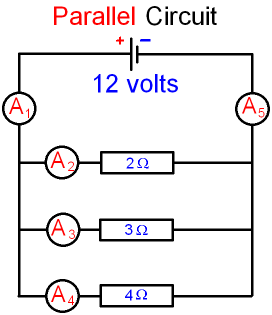
gcsescience.com 21 gcsescience.com
What is the Current in a Parallel Circuit?
1. In a
parallel circuit the current depends on the
resistance of
the branch (see the
calculation below).
2. The total
current flowing in
to the branches is
equal to the total current flowing
out of the branches.
In the circuit diagram below
A1 = A5

How to Calculate the Current in a Parallel Circuit.
The current at A2 flowing through the 2 ohm resistor
can be found using the equation V
= I
x R.
The equation can be rearranged to give
current
= voltage
÷ resistance
I =
V
÷ R
If the supply voltage is 12 volts,
I = V ÷ R
= 12 ÷ 2
= 6 amps.
See the next page for how to calculate the current
in
the other two resistors and the total
current in the circuit.
You would get the same answer for the
current in
the 2
ohm
resistor,
whether or not the other resistors
are
connected in the circuit.
For the parallel circuit
above, each
component behaves
as if it is
connected on its own to
the cell, and is unaware of the
other components.
See lamps
in a parallel circuit.
![]() Links
Electricity
Parallel Circuits
Revision Questions
Links
Electricity
Parallel Circuits
Revision Questions
![]()
gcsescience.com Physics Quiz Index Electricity Quiz gcsescience.com
Home GCSE Chemistry GCSE Physics
Copyright © 2015 gcsescience.com. All Rights Reserved.